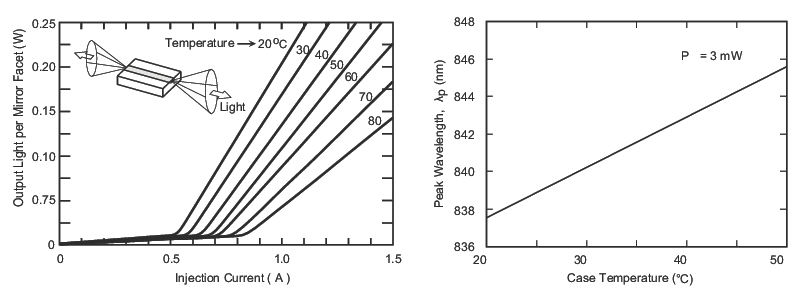Fundamentals of Laser Diode Control
Fundamentals of Laser Diode Control
Fundamentals of Laser Diode Control
Laser Diode Characterization
To assess the quality, performance, and characteristics of laser diodes, manufacturers often perform exhaustive testing which requires electro-optical, spectral and spatial characterization of the laser output. A laser diode's output is dependent on its injection current and temperature. Therefore, tightly controlling these parameters using laser diode current and temperature controllers is critical for extracting important operational parameters. An example of a laser diode test and characterization set-up is shown in Figure 1. Furthermore, laser diodes are expensive and have delicate electronic loads requiring controllers to be capable of protecting these devices while ensuring their output is stable. In general, the term "driver" typically refers to a current source while a "controller" often refers to an all-in-one current source and temperature-control mechanism. Current drivers and temperature controllers are discussed separately below.

Laser Diode Current Drivers
The most important laser diode characteristic is how its light output power (L) responds to injected current (I). This is referred to as the L-I curve (see Figure 2). This curve can be used to determine a number of significant parameters, including threshold current and threshold current density, differential responsivity, internal quantum efficiency, and external differential quantum efficiency. These values are usually listed in a laser diode's specification sheet so that a user can determine important operational parameters such as the current at which lasing begins, the drive current for a specific laser power, as well as the maximum current the device can take. Finally, the drive current can influence the laser's center wavelength (see Figure 2), so precise control of the current is also important for spectral control of the diode output.

Due to their sensitivity to injected current, laser diodes are typically driven by a stable current source. Other sources, e.g., voltage sources or generic power supplies, are too noisy for most applications and can generate voltage and current fluctuations and transients that may damage the laser diode. Specialized circuit designs have been developed to protect laser diodes from being damaged. The circuit designs typically include input AC power filtering and high-speed transient suppression circuits. Momentary internal transients may also occur when the output current is turned on or off. To guard against this, effective laser diode drivers short the output to the laser diode whenever the current is turned off. During the turn-on phase, the drivers ramp up the output current slowly to the desired set point value following a delay of several seconds. Another necessary feature of laser diode drivers is the independent current limit. which overrides any condition that may cause the output current to exceed the laser diode's maximum current rating. Features that maintain the stability of the operating current are crucial. Many controllers have a photodiode feedback mechanism built in for monitoring the output power. Since laser diodes generally emit light from both ends of their cavity, monitoring the rear facet output beam of the laser diode using a photodiode allows one to actively maintain the laser at a constant power level. Another advantage of laser diodes is that they can be directly modulated because of the linear dependence of the L-I curve above threshold (see Figure 2). An appropriate current driver can allow for modulation of the laser diode with frequencies up to several GHz or can be used to pulse the output.
Laser Diode Temperature Controllers
Figure 3 shows that the threshold current and differential responsivity of a laser diode are strongly affected by the laser's temperature. The laser threshold will increase exponentially with temperature as exp(T/T0), where T is the laser temperature and T0 is the "characteristic temperature" of the laser (typically between 60 to 150 °C). T0 is a measure of the temperature sensitivity of the device with higher values implying that the device is more thermally stable. T0 is an important laser diode characteristic and is commonly extracted from multiple L-I curves. Changes in temperature affect the bandgap of the semiconductor junction and therefore, the peak wavelength of the gain profile. This results in a linear relationship between temperature and the center wavelength of the laser diode (see Figure 3) with typical temperature tuning coefficients of 0.3 nm/°C. As a result, a temperature controller plays a key role in determining the laser wavelength.

Given the number of parameters that depend on laser diode temperature, it is important to set and maintain a stable temperature using a temperature controller. Most laser diode applications use thermoelectric (TE) coolers to maintain a constant temperature. TE coolers rely on the Peltier Effect, whereby driving current through p- and n-type semiconductor materials will cause them to transfer heat. The most important point to consider when using TE coolers is that they are heat pumps. In other words, they pump heat from the laser, which generates heat, to the heat sink, which dissipates heat. To achieve this heat pump action, current must be driven to the TE cooler in the proper direction. These solid-state devices can heat or cool small thermal loads to more than 60 °C from ambient and achieve temperature stabilities of better than 0.001 °C. An accurate temperature sensor attached to the laser diode allows the TE cooler to properly regulate the device's temperature. One type of sensor is a thermistor which is a resistance device that exhibits a voltage drop proportional to temperature. It is the most commonly used sensor because it is inexpensive, accurate, highly sensitive and easy to work with. It is also the smallest type of sensor, which makes it ideal for integration into laser diode packages.
Related Topics
Lasers
- Basic Light-Matter Interactions in Lasers
- Required Components for Lasing
- Characteristics of Laser Output
- Types of Lasers
- Methods for Pulsed-Laser Operation
- Spectral Tunability
- Classes of Lasers, Laser Safety, and Laser Damage
Laser Diodes and LEDs